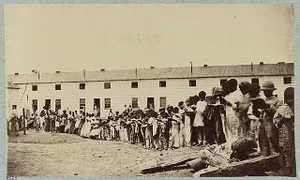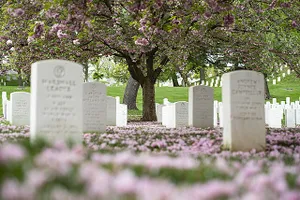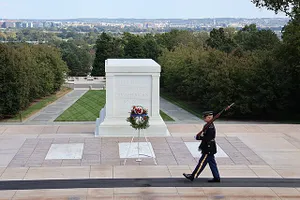Arlington National Cemetery is the final resting place for United States service members and their eligible family members as they are laid to rest with dignity and honor. Established in 1864, the cemetery spans 624 acres in Arlington, Virginia and contains more than 400,000 gravesites. It is often considered to be the most famous historic cemetery in the United States.
Unlike most U.S. national cemeteries, Arlington National Cemetery[1] is maintained by the U.S. Army rather than the National Cemetery Administration[2]. More than 3,000 burials and memorials take place at the cemetery every year.
History of Arlington National CemeteryHistory of Arlington National Cemetery

The tract of land on which Arlington National Cemetery resides once belonged to George Washington Parke Custis, the step-grandson of George Washington, first president of the United States. In 1857, Custis left the property in his will to his only child[3], Mary Anna Randolph Custis, wife of Robert E. Lee — including the family home, Arlington House, and 196 enslaved persons, who lived and worked on the plantation. [4]
Lee was a West Point graduate and the son of a three-term Virginia governor. When the U.S. Civil War began, Lee was appointed commander of the Confederate Army. In the spring of 1861, upon threat of occupation from Union troops, the Lees left Arlington House, never to return.
The estate then served as the camp and headquarters of the U.S. Army, from its strategic location on high ground across from the nation's capital. Three forts were built on the property during the Civil War: Fort Cass (now Fort Rosslyn), Fort Whipple (now Fort Myer) and Fort McPherson (now Section 11 of the cemetery).
Freedman's VillageFreedman's Village

On December 4, 1863, the federal government established a community for freed slaves on the southern end of the property. The community was called Freedman's Village and it became home to 1,500 people, with a hospital, schools, two churches, and a home for the elderly[5]. Emancipated slaves lived and farmed in Freedman's Village[6] until 1900, when the government closed it and incorporated the land into what had then become Arlington National Cemetery.
A confiscated estateA confiscated estate
In January of 1864, when Mary Anna Lee failed to pay taxes in person, as required by law at that time, the federal government formally confiscated the estate, "for government use, for war, military, charitable, and educational purposes."
By May of 1864, the existing Washington D.C. area national cemeteries (Soldiers’ Home and Alexandria National Cemeteries) were running out of space so Brigadier General Montgomery Meigs, Quartermaster General of the U.S. Army, who was responsible for the burial of soldiers, ordered that the Arlington Estate be used as a national cemetery.
Robert E. and Mary Anna Lee did not attempt to regain control of the Arlington home and land. But in 1874, the Lee's oldest son, George Washington Custis Lee, claimed that the Arlington property had been illegally confiscated and sued the U.S. government for its return. In December of 1882, the Supreme Court ruled in Lee's favor and the federal government purchased the property from Lee for $150,000 (the equivilent of $4 million today). Arlington National Cemetery then continued to serve as a burial ground for U.S. service members and their families.
Headstones at Arlington National CemeteryHeadstones at Arlington National Cemetery

Headstones at Arlington National Cemetery are uniform in shape, size, and materials. Like soldiers marching in formation, the gravestones are aligned in perfect rows and columns. They are made of either Georgia or Vermont marble and weigh 250 pounds. The gravestones are 4 inches deep, 13 inches wide and 42 inches tall.
The gravestones are engraved with the date of birth and death, the highest service rank attained, and all wars in which they served as active duty service members. The headstone may be adorned with one of 50+ religious symbols, or it may remain unadorned. Specially awarded medals are also noted, as are the names of spouses and/or dependent children who are buried alongside the Veteran.
Eligibility for burial at Arlington National CemeteryEligibility for burial at Arlington National Cemetery
Those who are eligible for interment at Arlington National Cemetery include:
- Active duty service members from any branch of the military
- Retired service member formerly on active duty
- Service members who have received the Medal of Honor, Silver Star, Purple Heart, Distinguished Service Cross or the Distinguished Service Medal
- American Prisoners of War who died on or after 1993[7]
- Spouses and dependent children of service members
Tomb of the Unknown SoldierTomb of the Unknown Soldier

The most famous grave at Arlington National Cemetery[1] is that of the Tomb of the Unknown Soldier. For more than 100 years the Tomb of the Unknown Soldier has served as a symbolic grave for all war dead whose remains have not been found or identified. The Tomb began with one unknown service member from World War I, and today is the grave of three unidentified service members.
The Guard is changed, during daylight hours, every thirty minutes in the summer (April 1 to Sep 30) and every hour in the winter (Oct 1 to Mar 31). During the hours the cemetery is closed, the guard is changed every 2 hours. The Tomb has been guarded, every minute of every day since 1937.[8]
Notable burials at Arlington National CemeteryNotable burials at Arlington National Cemetery
- Major Walter Reed, confirmed the theory that mosquitoes transmit yellow fever. His medical research enabled work to continue on the Panama Canal. Walter Reed National Military Medical Center is named in his honor. Click HERE to see his gravestone.
- Grace Hopper, was a pioneer in computer technology and co-inventor of COBOL. She is credited with being the first person to use the word “bug” to describe a problem with a computer program.
- Joe Louis Barrow known in the boxing world simply as Joe Louis, is considered one of the greatest heavyweights of all time. Along with his rank of "Technical Sergeant, U.S. Army", his nickname "The Brown Bomber" is inscribed on his gravestone. Click HERE to see his gravestone.
Explore more about famous cemeteriesExplore more about famous cemeteries
- Arlington National Cemetery, MyHeritage Catalog Collection
- Cemetery Records Worldwide, BillionGraves, MyHeritage Catalog Collection
- The Seven Largest Cemeteries in the World, BillionGraves Blog
- Three Amazing Cemeteries, BillionGraves Blog
- London's Magnificent Seven Cemeteries, BillionGraves Blog
- 10 Cemeteries to See Before You Die, BillionGraves Blog
- 10 of the World's Most Beautiful Cemeteries, BillionGraves Blog
- Accessing National Archives Military Records from Start to Finish, Legacy Family Tree Webinars
- Documenting Cemeteries with BillionGraves, Legacy Family Tree Webinars
References
- ↑ 1.0 1.1 https://www.arlingtoncemetery.mil/#/
- ↑ https://www.cem.va.gov/
- ↑ https://www.mountvernon.org/library/digitalhistory/digital-encyclopedia/article/george-washington-parke-custis/
- ↑ https://www.nps.gov/arho/learn/historyculture/robert-lee.htm
- ↑ https://www.arlingtoncemetery.mil/Explore/History-of-Arlington-National-Cemetery/Arlington-House
- ↑ https://www.arlingtoncemetery.mil/Explore/History-of-Arlington-National-Cemetery/Arlington-House
- ↑ https://www.arlingtoncemetery.mil/funerals/scheduling-a-funeral/establishing-eligibility
- ↑ https://www.arlingtoncemetery.mil/Explore/Monuments-and-Memorials/Tomb-of-the-Unknown-Soldier